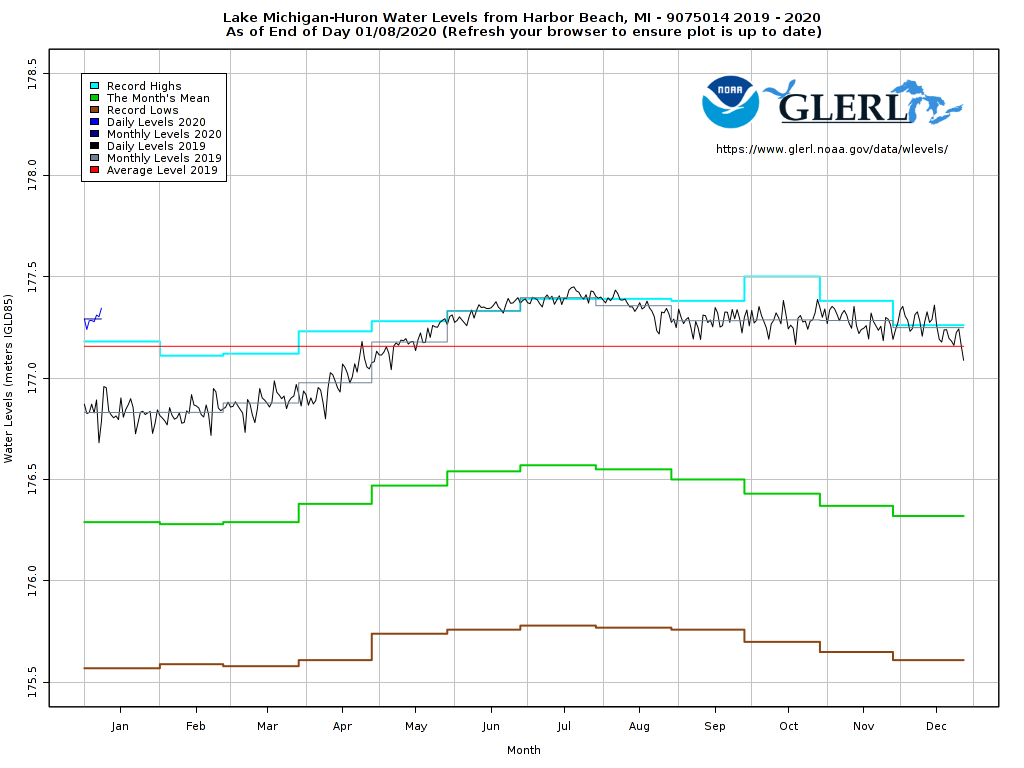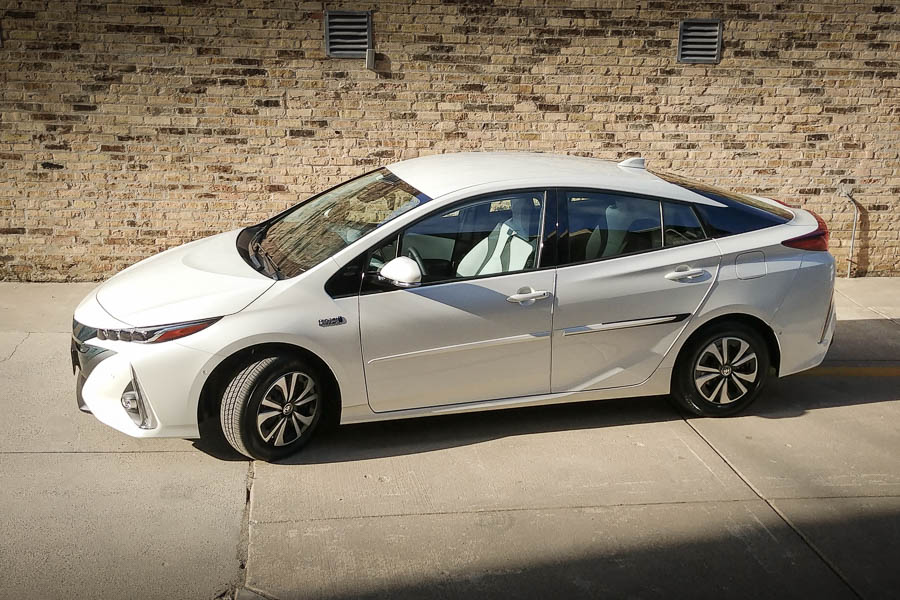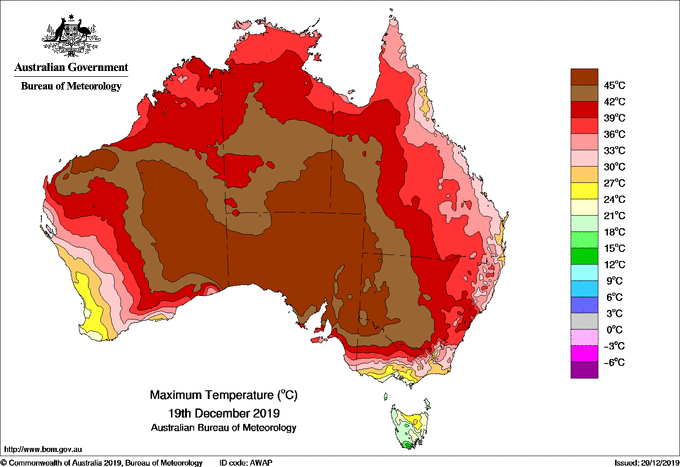Climate change has caused water levels in the Lake Michigan-Huron system to swell in only six years, creating havoc in communities that depend on them:
In 2013, Lake Huron bottomed out, hitting its lowest mark in more than a century, as did Lake Michigan, which shares the same water levels, according to data from the U.S. Army Corps of Engineers and the National Oceanic and Atmospheric Administration. Around that time, the lake withdrew so far from the shore around Engle’s resort — then a collection of 12 rustic cabins and three docks — that mud was all that remained beneath his boathouse.
In just 3½ years, levels rose more than 1.3 m and last summer peaked at nearly 1.9 m above the record low.
Climate change is amplifying variability in lakes that are naturally predisposed to fluctuation. Unlike lakes Ontario and Superior, which are regulated by dams and binational regulatory boards, lakes Michigan and Huron, measured as one body of water because they are connected at the Straits of Mackinac, have no such controls and consequently have experienced the greatest variation from record low to high in the Great Lakes.
As the amount of heat-trapping greenhouse gases has spiked over the past century, the Earth’s warmer atmosphere is capable of holding additional moisture, which scientists say is resulting in more frequent and severe storms. Across the Great Lakes region, precipitation has increased 14%, and the frequency of heavy storms has risen 35% since 1951, contributing to widespread flooding. In the past two years, the states of Michigan, Wisconsin, Indiana and Ohio each have endured a string of 12 consecutive months that have been the wettest in 124 years.
Here is the latest water-level chart from NOAA. Notice that last year's levels hit record highs during the summer and ended the year just below the record for December--meaning they started January considerably higher than the record for the month:

At least we have a lot of fresh water nearby. That might come in handy someday...
Not that anything has happened lately...
Finally, the New York Times had a feature yesterday on new architecture for Antarctic research stations. Cool stuff (ah ha ha).
Yesterday we broke a heat record; today the temperature feels more or less normal for late December; this weekend it will get warm again. Welcome to Chicago:
The record-breaking warmth comes on the heels of another historic ranking. With a high of 57 Wednesday, this year now ranks No. 2 on the list of warmest Christmas Days in Chicago since the mid-1800s, when records started being kept. The warmest Dec. 25 ever in Chicago was 17°C degrees in 1982.
But after the daytime high pushes the record for warmest Dec. 26 further out of reach, the city should brace for a rollercoaster of cold and warm days, [meteorologist Mark] Ratzer warned.
“Very late afternoon, it looks like probably just after dark, so between 5 and 7, a front will go through, and we’ll cool down markedly,” Ratzer said. “We’ll drop pretty quickly into the single-digits Celsius, which isn’t that bad, but overnight we’ll be back around freezing.”
After a brisk Friday, the temperature again will rebound into the low-teens Celsius in time for a mild and comfortable weekend, although it will be rainy, he said.
“Then we’ll cool off again by Monday,” Ratzer said.
Parker did not like the change at all, moping around on his two walks today like the ancient dog he has become. Maybe this weekend he'll feel more spring in his step again?
A year ago today, I got this lovely plug-in hybrid:

Because she (her name is Hana, or 初夏) has an on-board computer (well, probably a couple dozen, to be honest), I know exactly how well she did:
| Total distance |
6,969.4 km |
| Total fuel consumed |
186.7 L |
| Fuel economy |
2.7 L/100 km |
| Farthest north |
43.68°N |
| Farthest south |
41.32°N |
| Farthest east |
79.37°W |
| Farthest west |
87.96°W |
Sad to see she never made it all the way to the 88th meridian, given that I live only about 21 minutes east of it. But she did make it to five states and one Canadian province, with trips to Toronto and Cleveland.
In all, I filled up the car six times, five of those on road-trips, and spent only $130.77 on gasoline all year.
As I suspected when I went car shopping a year ago, a plug-in hybrid is the perfect car for me. On average I drove 18.6 km per day overall, which is deceptive because I didn't drive on 228 days of the last 366. On the 138 days I did drive, I averaged 50.5 km per day. Which again doesn't paint the full picture, because I only crested 50 km on 19 occasions, 100 km on 10, and 200 km on 4. Take those 19 days out and I averaged just 21 km per day.
In other words, out of 366 days, I needed to use gasoline about 30 times, and usually only a few centilitres per trip. Hana can go about 40 km on a charge in winter and 50 km in summer (because the heater uses more power than having the windows down).
For an urban dweller who primarily uses public transportation, but who occasionally needs to haul a big old dog somewhere or go out of town, a plug-in hybrid makes a ton of sense. And it's fun to drive, too.
(Say it with me: "Under where?")
Australia just hit a record temperature—for the whole country:
The Australian Bureau of Meteorology (BOM) reports preliminary data showing that for Dec. 18, the nationally averaged maximum temperature was 41.9°C. This beat the old record of 40.9°C, which had been set the day before. Before this heat event, the country’s hottest day was Jan. 7, 2013, which had an average high temperature of 40.3°C.

Human-caused global climate change is making heat waves such as this one more likely to occur, more severe and longer-lasting. An early analysis of the ongoing heat event shows that climate change may have made the Australian national heat record at least 20 percent more likely to occur now than in a climate that had not been influenced by human emissions of greenhouse gases. It’s possible that forthcoming research will show that this event could not have occurred without human-caused global warming, as previous analyses of other events have found.
That's insane. Not to mention the extensive brush fires—including the largest ever recorded in Australia—that have rendered Sydney almost uninhabitable.
The US government's 2019 Arctic Report Card finds that melting permafrost has made the arctic a net producer of greenhouse gasses:
Especially noteworthy is the report’s conclusion that the Arctic already may have become a net emitter of planet-warming carbon emissions due to thawing permafrost, which would only accelerate global warming. Permafrost is the carbon-rich frozen soil that covers 24 percent of the Northern Hemisphere’s land mass, encompassing vast stretches of territory across Alaska, Canada, Siberia and Greenland.
Warming temperatures allow microbes within the soil to convert permafrost carbon into the greenhouse gases — carbon dioxide and methane — which can be released into the air and accelerate warming. Ted Schuur, a researcher at Northern Arizona University and author of the permafrost chapter, said the report “takes on a new stand on the issue” based on other published work including a study in Nature Climate Change in November.
Taking advantage of the new studies — one on regional carbon emissions from permafrost in Alaska during the warm season, and another on winter season emissions in the Arctic compared to how much carbon is absorbed by vegetation during the growing season — the report concludes permafrost ecosystems could be releasing as much as 1.1 billion to 2.2 billion tons of carbon dioxide per year. This is almost as much as the annual emissions of Japan and Russia in 2018, respectively.
Only, if you can believe, it's worse than that. Because the microbes also produce methane, which gram-for-gram causes about 4 times more warming. And as the region gets warmer, more microbes produce more gas, in a negative spiral.
Happy Wednesday.
Let me first acknowledge that the biggest news story today today came from the House Judiciary Committee, which has drawn up two articles of impeachment against President Trump. This comes after committee chair Jerry Nadler nearly lost control of yesterday's meeting.
As Josh Marshall points out, no one expects the Senate to remove the president from office. So the Democratic Party's job is just to demonstrate how much malfeasance and illegality the Republican Party will tolerate from their guy.
If only that were the only story today.
And tonight, I get to preside over a condo-board meeting that will be at least as fun as yesterday's Judiciary Committee meeting.
A new United Nations report projects that the world's average temperature will hit 3.9°C above pre-industrial levels in 80 years without massive, immediate cuts in greenhouse-gas emissions. The additional energy the atmosphere has absorbed in the 80 years has given us the perfect Thanksgiving weekend travel environment:
Not one, not two, but three powerful storm systems will make travel difficult to near impossible at times both before and after Thursday’s holiday.
A record-breaking “bomb cyclone” crashed ashore in the Pacific Northwest on Tuesday night, bringing winds gusting over 160 km/h and feet of snow in some areas. That storm system will continue to dump snow in the Sierra Nevada while bringing heavy rain, coastal flooding and even isolated thunderstorms to Southern California. It will also spread rain and snow into Utah, Nevada and Colorado.
Meanwhile, a “kitchen sink” storm barreling through the Plains and Upper Midwest has already manifested itself in offering the worst of every season. Tornadoes touched down in Louisiana, while thundersnow and thundersleet rattled Nebraska. This is coming on the heels of Denver’s snowiest day in three years.
The snow is targeting the Great Lakes this hour, as strong winds spread over much of the Mississippi and Ohio valleys. The winds, gusting up to 97 km/h at times, threaten to snarl air travel into and out of Chicago’s major hubs at O’Hare and Midway airports.
And that’s not all. The same upper-level disturbance that helped spin up the West Coast bomb cyclone will generate a third potent storm to the east. It will probably impact the eastern half of the Lower 48 this weekend.
Right now at O'Hare winds are 38 km/h gusting to 70 km/h with a peak gust of 98 km/h recorded at 10:11 this morning. As my first flight instructor used to say, "Mights gonna to be a bit vindy."
And it's not even lunchtime yet:
- A storm has left Venice flooded under 187 cm of water, the second highest flood since records began in 1923. Four of the five largest floods in Venice history have occurred in the last 20 years; the record flood (193 cm) occurred in 1966.
- As our third impeachment inquiry in 50 years begins public hearings, Josh Marshall explains what the Democrats have to prove.
- Yoni Appelbaum wonders if the country can hold together. He's not optimistic.
- Via Bruce Schneier, the NTSB has released a report on the autonomous car accident in 2018 that killed Elaine Herzberg. A notable detail: "Police investigators later established that the driver had likely been streaming a television show on her personal smartphone."
- Chicago Tribune restaurant critic Phil Vettel lists his 50 favorite restaurants in the area. I have a mission.
And you should see Sir Rod Stewart's model railroad. Jaw-dropping.
We have pretty normal autumn weather in Chicago right now, in that it's gray and cold with temperatures about 3°C below normal. Friday morning, when I fly out, temperatures will fall to 10°C below normal and then 13°C below normal when I get back Tuesday.
We have this ridiculous late-autumn chill because of climate change. Warm air over Greenland and the Grand Banks has distorted the circumpolar jet stream into an omega shape, bringing the Arctic to Canada and the central US and bringing California to Alaska. Check out the map.
I'll just have to drive to O'Hare and leave a winter coat in my car, I suppose.